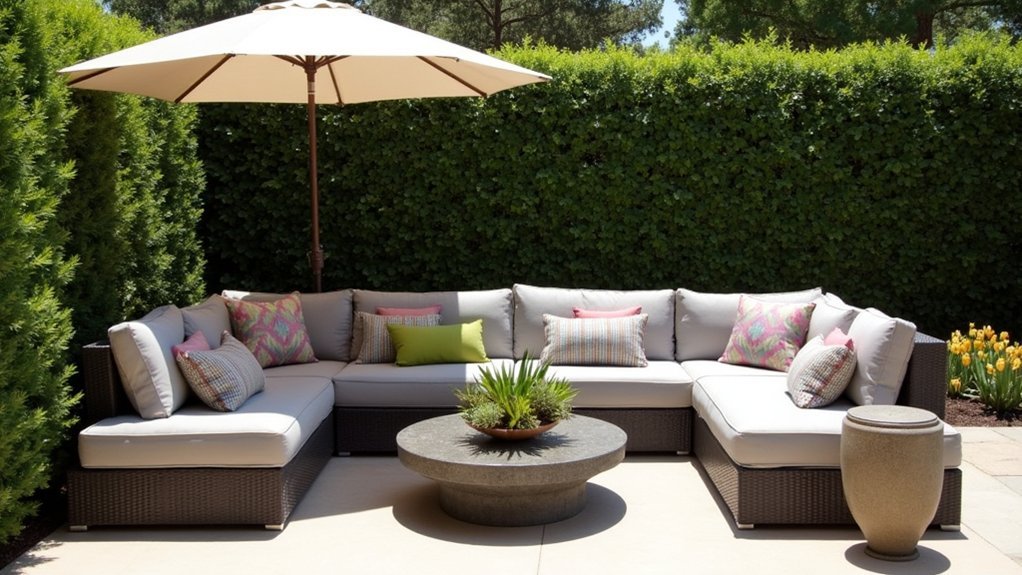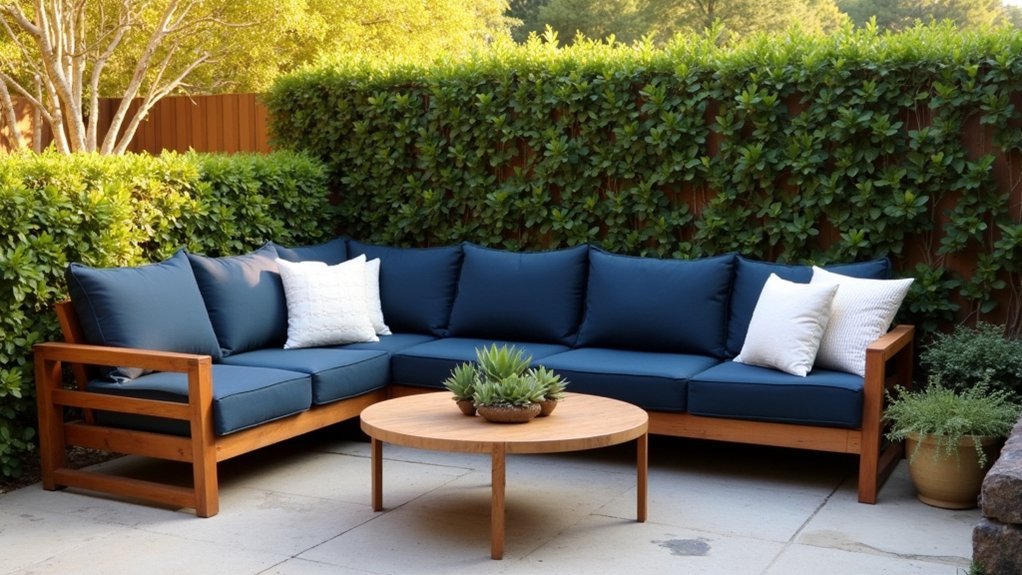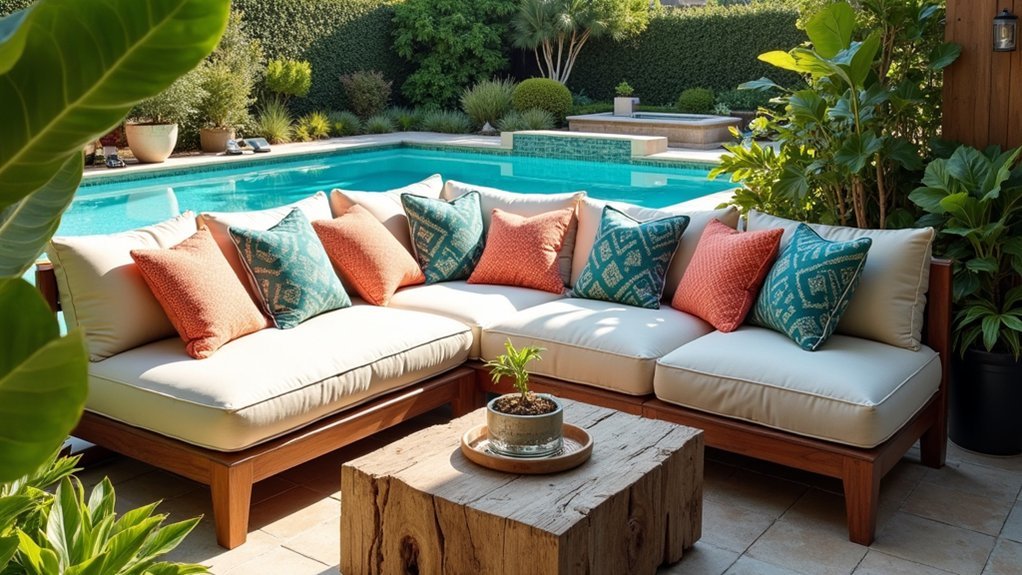When choosing the perfect outdoor sectional, start by measuring your space and allowing 2-3 feet of clearance around all sides for comfortable movement. Consider L-shaped designs for compact patios or U-shaped configurations for larger entertaining areas. Select weather-resistant materials like aluminum frames or synthetic wicker that’ll withstand your climate. Match neutral colors to your existing outdoor aesthetic, and choose between modular pieces for flexibility or fixed designs for streamlined appearance. Understanding these foundational elements will guide you toward additional considerations that guarantee your investment enhances every outdoor gathering.
Understanding Outdoor Sectional Types and Configurations

When selecting an outdoor sectional, you’ll encounter several distinct configurations that each serve different purposes and spatial requirements.
L-shaped sectionals work perfectly for compact patios, maximizing corner space while delivering substantial seating arrangements without overwhelming smaller outdoor spaces.
L-shaped sectionals maximize corner space efficiently, providing ample seating for compact patios without creating visual clutter or overwhelming smaller areas.
U-shaped sectionals create conversation-focused environments ideal for larger areas, accommodating more guests in a semi-enclosed layout that encourages interaction.
Modular sectionals offer ultimate versatility through individual pieces you can rearrange based on changing needs and activities. These flexible layouts adapt to different occasions, from intimate gatherings to larger entertainment events.
Curved configurations soften harsh architectural lines and work beautifully around fire pits or focal points.
Understanding these distinct outdoor sectional types helps you match the right configuration to your specific space and entertaining style.
Measuring Your Entertainment Space for Optimal Fit
Before you fall in love with a specific sectional design, you’ll need to measure your outdoor space precisely to guarantee it fits comfortably and functions well.
Start by recording the exact length, width, and height dimensions of your entertainment area, then use painter’s tape or chalk to map out your proposed layout directly on the ground.
This visual approach helps you plan proper traffic flow and confirms you’ve allowed adequate clearance space around the sectional for easy movement.
Accurate Space Measurements
One critical step that’ll determine your outdoor sectional’s success is taking precise measurements of your entertainment area. Use a measuring tape to record the exact length and width of your seating area, then consider how the size and layout will accommodate your chosen outdoor furniture.
Mark the sectional layout using painter’s tape or chalk to visualize the footprint on your deck or patio. Don’t forget to account for comfortable traffic flow by allowing 2-3 feet of clearance around all sides.
Check the dimensions of existing furniture like tables or loungers to guarantee they won’t overcrowd the space. These accurate space measurements prevent costly mistakes and assure your outdoor sectional fits perfectly within your entertaining zone.
Traffic Flow Planning
How will guests move around your outdoor sectional once it’s in place? You’ll need to plan clear traffic flow before selecting your sectional for your outdoor entertainment area.
When you measure your outdoor space, visualize pathways that allow comfortable movement between seating and other areas. Use painter’s tape to outline the sectional’s footprint, ensuring at least 24 to 36 inches of clearance around all sides.
L-shaped sectionals work well in corners and naturally create walking paths, while U-shaped sectionals require more strategic positioning to maintain flow.
Don’t forget to account for additional furniture like coffee tables or side tables when planning your layout. This thoughtful approach creates a cohesive entertainment area where guests can move freely without feeling cramped or obstructed.
Layout Mapping Techniques
Accurate measurements form the foundation of your traffic flow planning and prevent costly sizing mistakes.
Begin your layout mapping by measuring your outdoor area’s length, width, and height, noting architectural features that impact sectional placement. Use painter’s tape or chalk to outline your desired outdoor sectional furniture dimensions directly on the surface—this visualization technique guarantees ideal fit before purchase.
Consider the orientation of space by evaluating sightlines and sun exposure for maximum comfort.
Maintain 18-24 inches clearance for movement around the sectional, enabling easy access to other areas. Include all furniture elements like tables and chairs in your measurements to create a cohesive layout.
This thorough approach accommodates all outdoor activities while maximizing your entertainment space’s functionality and aesthetic appeal.
Selecting Weather-Resistant Materials for Durability
You’ll want to focus on two critical aspects when choosing materials that can withstand the elements: the frame construction and fabric performance.
The frame serves as your sectional’s foundation, so selecting materials like aluminum, synthetic wicker, teak, or HDPE will determine how well it resists rust, UV damage, and weather-related deterioration.
Your fabric choice is equally important, as it directly impacts both comfort and longevity through features like water resistance, stain protection, and UV stability.
Frame Material Options
When selecting an outdoor sectional, the frame material determines how well your investment will withstand years of exposure to sun, rain, and temperature fluctuations.
Aluminum frames offer lightweight construction with rust-resistant properties, making them perfect for coastal areas where saltwater threatens other materials.
Teak wood provides premium durability through natural oils that resist moisture and prevent rotting.
Synthetic wicker made from polyethylene delivers excellent UV protection while maintaining its appearance.
Steel frames suit modern aesthetics but require more maintenance in damp climates.
High-density polyethylene creates weather-resistant materials that mimic wood’s beauty without the upkeep.
- Picture your outdoor sectional sofa standing strong against ocean spray and salt air
- Envision durable furniture that maintains its rich color after countless summer storms
- Imagine relaxing on materials that look pristine year after year
Fabric Performance Features
While your sectional’s frame provides the structural foundation, the fabric you choose determines how comfortable and attractive your outdoor furniture remains through seasons of weather exposure.
Look for weather-resistant materials like Sunbrella or olefin that deliver long-lasting performance against UV rays, moisture, and mildew. Water-repellent coatings prevent absorption, protecting your outdoor sectional from rain damage and staining.
You’ll want fade-resistant fabrics that maintain vibrant colors despite prolonged sunlight exposure, keeping your furniture looking fresh rather than worn. Anti-microbial properties resist mold and mildew growth, creating a cleaner seating environment.
Choose removable cushion covers that are machine-washable for effortless maintenance and convenient cleaning throughout the outdoor season.
Choosing the Right Seating Capacity for Your Guest List

How many guests do you typically entertain in your outdoor space? Determining the right seating capacity for your outdoor sectional starts with analyzing your guest list. For intimate gatherings of 4-6 people, a standard sectional works perfectly.
However, larger U-shaped configurations can accommodate 8 or more guests comfortably.
Consider these seating solutions for different scenarios:
- L-shaped sectionals maximize corner spaces while providing seating for multiple guests in limited space.
- Modular sectionals offer flexibility to rearrange or expand as your entertaining needs grow.
- U-shaped configurations create conversation-friendly layouts for larger gatherings.
Measure your outdoor space accurately to guarantee proper fit without overcrowding.
Think about traffic flow and seating configuration—you’ll want easy access between sections and room for additional furniture when planning your perfect outdoor entertaining setup.
Evaluating Comfort Features for Extended Gatherings
Since outdoor gatherings often extend for hours, you’ll want to prioritize comfort features that keep guests relaxed and happy throughout the entire event.
Look for high-density foam cushions that provide superior support during long conversations and meals. Deep seat designs encourage lounging while promoting natural socializing positions. Consider removable cushion covers for easy maintenance after frequent use.
Pay attention to armrest height and back support to accommodate various guest preferences and body types. These elements greatly impact comfort during extended outdoor seating sessions.
Additionally, seek sectionals with integrated side tables or built-in storage features. These additions enhance functionality by providing convenient access to drinks, snacks, and personal items without requiring guests to leave their comfortable positions throughout your gathering.
Matching Style and Color to Your Outdoor Aesthetic

What makes an outdoor sectional truly shine in your space? It’s all about harmonizing style and color with your outdoor aesthetic.
Start with neutral colors as your foundation—they’re timeless and effortlessly pair with colorful cushions for vibrant appeal. Consider your existing architecture when selecting styles; modern sectionals complement sleek minimalism while rustic designs enhance natural wooden elements.
Use color theory strategically: warm tones create inviting atmospheres, cool colors promote calming effects. Coordinate material finishes with other outdoor elements for a cohesive look that flows seamlessly.
- Picture a charcoal sectional against white stucco walls with coral accent pillows
- Imagine weathered teak frames complementing natural stone patios
- Visualize navy cushions creating striking contrast on cream wicker
Add patterns and textures through throws and pillows to enhance visual interest while maintaining harmony.
Comparing Modular Vs Fixed Sectional Designs
Two distinct approaches define outdoor sectional design: modular and fixed configurations.
A modular outdoor sectional consists of individual pieces you can rearranged for customizable layouts, while fixed sectionals maintain predetermined shapes that limit flexibility.
Modular designs offer exceptional versatility for your outdoor living space, allowing you to create various seating configurations like L-shapes or U-shapes that adapt to changing needs. You’ll also appreciate the expansion potential and easier off-season storage when pieces disassemble.
Fixed sectionals provide a streamlined, cohesive appearance but can’t accommodate layout modifications once purchased.
Consider your space’s evolution and storage requirements when choosing between these outdoor use options, as modular systems excel in adaptability while fixed designs prioritize aesthetic unity.
Budget Considerations and Price Comparison Strategies

While outdoor sectionals represent a significant investment, understanding your budget parameters and implementing strategic price comparison techniques will help you secure the best value for your money. Expect to spend $300 to $2,500 depending on material and size, with high-end options offering superior durability and warranty coverage.
Smart budget considerations include factoring in hidden costs like shipping, assembly, and protective covers, which can increase your total by 10-20%. Compare prices across multiple retailers since seasonal promotions can offer up to 50% savings.
Factor in shipping, assembly, and cover costs that can add 10-20% to your total furniture investment.
- Picture yourself relaxing on a weathered teak sectional that’s weathered five summers beautifully.
- Imagine discovering your dream sectional marked down 40% during an end-of-season clearance event.
- Visualize reading customer reviews that reveal which budget-friendly pieces still look pristine after years outdoors.
Many retailers offer financing options, making premium sectionals more accessible through interest-free payment plans.
Maintenance Requirements for Long-Term Performance
After securing your ideal outdoor sectional at the right price, protecting that investment requires consistent maintenance practices that keep your furniture looking pristine for years to come. Understanding maintenance requirements guarantees long-lasting use of your outdoor sectionals while preventing costly replacements.
| Maintenance Task | Frequency | Benefits |
|---|---|---|
| Clean outdoor furniture with mild soap | Weekly | Prevents dirt and grime buildup |
| Apply protective covers | During storms/off-season | Shields from UV rays and moisture |
| Store in covered area | Winter months | Extends lifespan considerably |
| Wash cushion covers | Monthly | Maintains fresh appearance |
Choose sectionals with removable machine-washable cushion covers for effortless upkeep. Regularly clean your furniture following material-specific guidelines—wicker needs different care than aluminum. Protective covers during inclement weather prevent fading and material deterioration, maximizing your investment’s value.
Frequently Asked Questions
What Is the Best Material for Outdoor Sectional?
You’ll want teak wood or synthetic wicker with aluminum frames for durability. Choose high-density polyethylene wicker for UV protection and pair with Sunbrella performance fabrics that resist water and mold effectively.
How to Choose the Best Outdoor Furniture?
You’ll want to contemplate your space’s size, choose weather-resistant materials like teak or aluminum, prioritize comfort with quality cushions, and select styles that complement your existing outdoor decor perfectly.
How to Tell if a Sectional Is Good Quality?
Check the frame material for rust-resistant aluminum or teak, examine reinforced stitching quality, test cushion density, and consider the sectional’s weight. You’ll want performance fabrics like Sunbrella and positive customer reviews indicating durability.
How to Pick the Right Sectional?
Measure your space first, then choose weather-resistant materials like teak or aluminum. Select L-shaped, U-shaped, or modular configs based on seating needs. Prioritize quick-dry cushions with washable covers.





Leave a Reply